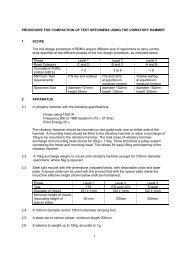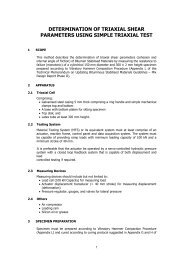Updating Bituminous Stabilized Materials Guidelines Mix Design Report Phase II
Moisture Sensitivity: Part II (Validation) - Asphalt Academy
Moisture Sensitivity: Part II (Validation) - Asphalt Academy
- No tags were found...
You also want an ePaper? Increase the reach of your titles
YUMPU automatically turns print PDFs into web optimized ePapers that Google loves.
The set-up of the test before trafficking commences, is a time consuming procedure. After the<br />
specimens fastened into the steel beam, water is filled to a level in the bath 2mm above the<br />
specimen’s surface. The water depth is kept steady by a weir at the end of the bath. The water<br />
is pumped out of the weir and repeats the cycle all the time to maintain water level.<br />
The water temperature during testing maintained at 25ºC using a thermally adjustable water<br />
pump. The number of load repetitions at which profile measurements are taken differs according<br />
to the type of BSM. Generally, more measurements are made early on during the test i.e. at<br />
shorter intervals, because the rutting profile has an exponential relationship with time. However,<br />
as shown in the following table, the number of load repetitions at which the MMLS3 test is<br />
terminated, can vary significantly:<br />
Table J.2: The number of load repetitions per measurement cycle wet condition<br />
BSM Type<br />
Loads per measurement cycle [No]<br />
Initial (preliminary ) test<br />
2% emulsion +1% cement<br />
DNM 50 000 75 000 100 000<br />
(long cured)<br />
2% emulsion + 0% cement (G2) 0 500 900 Failure<br />
2% emulsion + 1% cement (G2) 0 250 Failure -<br />
2% foam + 0% cement (G2) 0 250 Failure -<br />
Additional test<br />
2% emulsion +1% cement (H-RAP) 0 45000 Failure<br />
2% emulsion +1% lime (H-RAP) 0 45000 Failure<br />
2% emulsion +0% cement (H-RAP) 0 2500 Failure<br />
2% emulsion +0% cement (Q-G4) 0 2500 Failure<br />
Failure = means ravelling –depth more than 12mm<br />
After identification of the number of wet-trafficked axles to failure for a specific mix, the second<br />
set of briquettes tested under dry condition to the same number of load application applied for<br />
wet condition. Thereafter two sets specimens (dry and wet) could be tested in the ITS mode to<br />
determine the tensile strength retained TSR i.e. wet over dry.<br />
2.4 ITS Testing<br />
Subsequent to trafficking, Indirect Tensile Strength (ITS) tests carried out on the specimens<br />
removed from the MMLS3 test set-up. These tests results were then compared with ITS tests<br />
performed on specimens not subjected to wet trafficking. In this way, a TSR result assessed for<br />
the different BSM-mixes.<br />
The Indirect Tensile Strength test performed using MTS equipment. The loading rate applied<br />
during ITS test is 50.8mm/min. The Indirect Tensile Strength and tensile strength ratio of the<br />
BSMs computed as follows, Equation 1 and 2:<br />
13












